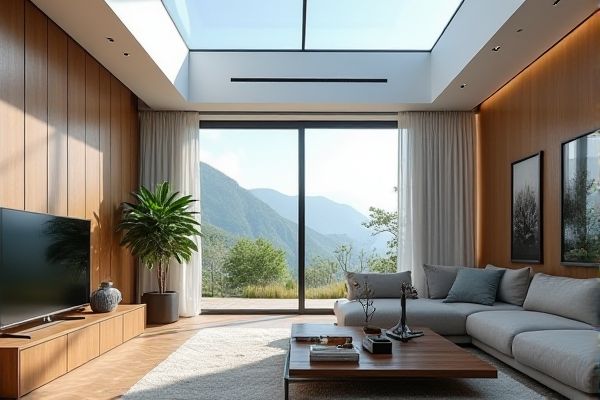
Transparent roof panels allow maximum natural light to enter, creating bright and open spaces, while tinted panels reduce glare and heat by filtering sunlight, enhancing comfort and energy efficiency. Explore this article to determine which roof panel best suits Your needs and environment.
Table of Comparison
| Feature | Transparent Roof Panel | Tinted Roof Panel |
|---|---|---|
| Light Transmission | High, allows maximum natural light | Reduced, limits glare and brightness |
| Heat Control | Low, can increase interior heat | Better, reduces heat buildup |
| Privacy | Low, fully visible through | High, obscures view from outside |
| UV Protection | Minimal, depends on material | Enhanced, blocks more UV rays |
| Aesthetic | Clear, modern look | Varied shades, sleek appearance |
| Cost | Typically lower price | Usually higher due to tinting process |
| Applications | Sunrooms, greenhouses, patios | Commercial buildings, cars, residential roofing |
Introduction to Roof Panels: Transparent vs. Tinted
Transparent roof panels maximize natural light penetration, enhancing indoor brightness and reducing the need for artificial lighting. Tinted roof panels offer solar heat control by filtering sunlight, which helps in maintaining cooler indoor temperatures and reducing glare. Both options provide durable weather resistance but serve distinct purposes based on lighting and thermal management needs.
Material Composition of Transparent and Tinted Panels
Transparent roof panels are typically made from polycarbonate or acrylic materials that offer high light transmission and durability, allowing maximum natural sunlight into your space. Tinted panels incorporate additives like UV inhibitors and color pigments to reduce glare, improve energy efficiency, and protect interiors from harmful UV rays. The choice between transparent and tinted materials impacts heat control, visibility, and overall roof panel performance based on your specific needs.
Light Transmission and Natural Illumination
Transparent roof panels offer superior light transmission, allowing up to 90% or more of natural sunlight to enter interior spaces, which enhances natural illumination and reduces reliance on artificial lighting. Tinted roof panels typically transmit between 20% to 60% of light depending on the tint level, reducing glare and heat gain while providing moderate natural light penetration. Choosing between transparent and tinted panels impacts energy efficiency and comfort, with transparent panels maximizing daylight and tinted panels balancing light control and solar heat reduction.
Heat Control and Energy Efficiency
Transparent roof panels allow maximum natural light but offer limited heat control, often increasing indoor temperatures and cooling costs. Tinted panels reduce solar heat gain by blocking a portion of sunlight, enhancing energy efficiency and maintaining cooler indoor environments. Choosing the right panel impacts your building's energy consumption by balancing natural illumination with effective temperature regulation.
UV Protection and Panel Performance
Transparent roof panels allow maximum natural light, but often lack inherent UV protection, which can lead to increased interior heat and potential material degradation. Tinted panels filter harmful UV rays effectively, reducing heat buildup and protecting your space while maintaining good visibility. Choosing tinted panels enhances your roof's performance by balancing sunlight penetration with UV defense and energy efficiency.
Aesthetic Appeal and Design Flexibility
Transparent roof panels enhance aesthetic appeal by allowing maximum natural light, creating bright, open spaces that accentuate architectural details. Tinted panels offer design flexibility by controlling light intensity and reducing glare, enabling you to achieve desired ambiance and improve energy efficiency. Choosing between transparent and tinted panels depends on your aesthetic goals and functional needs for light management.
Privacy Considerations for Different Panel Types
Transparent roof panels offer maximum natural light but provide minimal privacy, making them ideal for spaces where visibility is desired and privacy is not a primary concern. Tinted panels, by filtering light and reducing glare, enhance privacy by obscuring the view from above and limiting visibility into the interior space. Choosing between transparent and tinted panels depends on balancing natural illumination needs with the level of privacy required for the specific architectural application.
Maintenance and Longevity Comparison
Transparent roof panels typically require more frequent cleaning to maintain clarity and prevent yellowing caused by UV exposure, while tinted panels often have UV-resistant coatings that reduce maintenance needs. Tinted panels generally offer longer durability by minimizing heat buildup and glare, which can extend the lifespan of roofing materials beneath. Your choice between these panels should consider maintenance commitment and desired longevity based on environmental conditions.
Cost Analysis: Transparent vs. Tinted Roof Panels
Transparent roof panels typically cost more upfront than tinted panels due to higher-quality materials designed to maximize natural light transmission while maintaining durability. Tinted roof panels offer cost savings by reducing cooling expenses with their heat rejection properties, lowering energy bills over time despite a lower initial price. Your choice depends on balancing initial investment against long-term energy efficiency benefits.
Choosing the Right Panel for Your Project
Transparent roof panels maximize natural light, enhancing interior brightness and reducing the need for artificial lighting, making them ideal for sunrooms and greenhouses. Tinted roof panels offer UV protection and glare reduction, improving energy efficiency and comfort in commercial or residential spaces exposed to intense sunlight. Selecting the right panel depends on balancing light transmission with heat control and the specific requirements of your building project.
 homyna.com
homyna.com